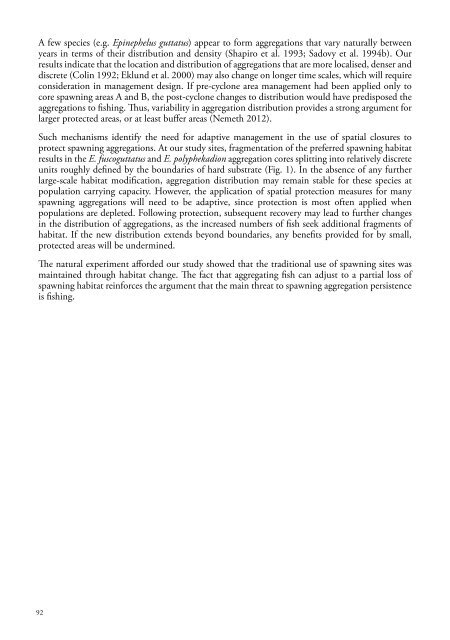WIOMSA-CORDIO spawning book Full Doc 10 oct 13.pdf
WIOMSA-CORDIO spawning book Full Doc 10 oct 13.pdf
WIOMSA-CORDIO spawning book Full Doc 10 oct 13.pdf
Create successful ePaper yourself
Turn your PDF publications into a flip-book with our unique Google optimized e-Paper software.
A few species (e.g. Epinephelus guttatus) appear to form aggregations that vary naturally betweenyears in terms of their distribution and density (Shapiro et al. 1993; Sadovy et al. 1994b). Ourresults indicate that the location and distribution of aggregations that are more localised, denser anddiscrete (Colin 1992; Eklund et al. 2000) may also change on longer time scales, which will requireconsideration in management design. If pre-cyclone area management had been applied only tocore <strong>spawning</strong> areas A and B, the post-cyclone changes to distribution would have predisposed theaggregations to fishing. Thus, variability in aggregation distribution provides a strong argument forlarger protected areas, or at least buffer areas (Nemeth 2012).Such mechanisms identify the need for adaptive management in the use of spatial closures toprotect <strong>spawning</strong> aggregations. At our study sites, fragmentation of the preferred <strong>spawning</strong> habitatresults in the E. fuscoguttatus and E. polyphekadion aggregation cores splitting into relatively discreteunits roughly defined by the boundaries of hard substrate (Fig. 1). In the absence of any furtherlarge-scale habitat modification, aggregation distribution may remain stable for these species atpopulation carrying capacity. However, the application of spatial protection measures for many<strong>spawning</strong> aggregations will need to be adaptive, since protection is most often applied whenpopulations are depleted. Following protection, subsequent recovery may lead to further changesin the distribution of aggregations, as the increased numbers of fish seek additional fragments ofhabitat. If the new distribution extends beyond boundaries, any benefits provided for by small,protected areas will be undermined.The natural experiment afforded our study showed that the traditional use of <strong>spawning</strong> sites wasmaintained through habitat change. The fact that aggregating fish can adjust to a partial loss of<strong>spawning</strong> habitat reinforces the argument that the main threat to <strong>spawning</strong> aggregation persistenceis fishing.92


















